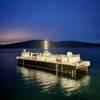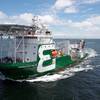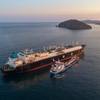Preventing Barge Explosions
Recent casualties involving explosions aboard barges conducting tank cleaning operations alongside marine terminals have resulted in serious injuries to vessel crews and facility workers, catastrophic property damage, as well as harm to the environment. A review of related casualties has revealed that vessel personnel, facility personnel and shore side managers failed to ensure that established procedures and safe practices were followed. Specifically, the Operational Manuals and regulatory requirements were not routinely followed by those involved. As a result unintended and disastrous consequences occurred.
This safety alert aims to raise awareness regarding this issue and highlight critical lessons learned from these incidents. Facility and vessel managers and operators, both ashore and afloat, responsible for the oversight of, or specifically involved in tank cleaning, stripping or gas freeing of flammable cargoes, should take note and ensure the widest distribution to all personnel.
Title 33 Code of Federal Regulations (CFR) Part 154 - Facilities Transferring Oil or Hazardous Material in Bulk; requires facilities to submit for approval to the Captain of the Port (COTP), an Operations Manual that provides facility details, types of cargos handled, duties/knowledge requirements of specific personnel, locations of emergency shutdowns, descriptions of tank cleaning procedures, emergency procedures, and other requirements for each type of cargo evolution, tank cleaning, and vapor control processes. For facilities that conduct tank cleaning, stripping, or gas freeing operations on tank vessels, the Operations Manual must contain a description of their procedures that are consistent with the International Safety Guide for Oil Tankers and Terminals (ISGOTT). Specific sections of the Fifth edition are referenced in 33 CFR Part 154.
The most common causal factor associated with these tank barge explosions is that the Person in Charge (PIC) of the facility and/or tank barge failed to follow key Operating Manual procedures.
As a result of these casualties the Coast Guard strongly recommends that facility and vessel managers, operators and PIC's performing tank cleaning, stripping, or gas freeing of flammable cargos on board any vessel review ISGOTT Fifth edition and fully comply with all related regulations and Operating Manuals while also ensuring (among many other items):
- Operations Manual is complete and meets regulatory requirements.
- Facility personnel training programs meet regulatory requirements.
- Facility PIC is designated and properly trained.
- Barge PIC holds a required valid USCG Merchant Mariner's Credential with a Tankerman-PIC endorsement.
- Barge or vessel is properly grounded by a bonding wire or other approved method prior to transfer of cargo or slops.
- Spark producing tools and machinery are removed from the involved barge or vessel and immediate vicinity.
- Portable fans or blowers used to ventilate tanks are intrinsically safe and properly grounded.
- Minimizing the operation of other vessels near the facility during tank cleaning or gas freeing operations to reduce potential vapor ignition sources.
- Operating manual procedures for dropping / draining and cleaning of cargo lines and piping and tank cleaning are strictly followed.
- During tank cleaning (washing) and gas-freeing operations, consistent with ISGOTT Ch 11.3, conduct water flushing of the tank bottom and piping systems while monitoring the Lower Flammable Limit (LEL) prior to commencing forced ventilating.
- A Certified Marine Chemist certifies tanks as "Safe for Workers," "Safe for Hotwork" before personnel enter that tank or conduct hot work.
Facility and vessel operators may submit a written request for the COTP to consider alternative procedures, methods, or equipment standards than those established within the ISGOTT or regulations. The COTP will evaluate any proposed alternative to ensure it provides an equivalent level of safety and pollution protection as required by the regulations.
This Safety Alert is provided for informational purposes only and does not relieve any domestic or international safety, operational or material requirement. It was developed by the U.S. Coast Guard Eighth District Prevention division in coordination with the Office of Investigations and Casualty Analysis, Washington DC.










